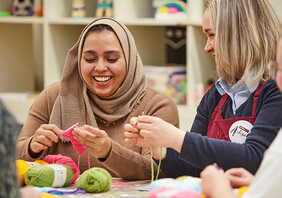How to Make a DIY Typography Art Print
Create an eye-catching typography print with acrylic paint using our free template! Our easy-to-follow tutorial will show you the simple steps to make this inspiring print.
This print is completely customisable, so you can get creative and use a different quote or experiment with colours that suit your décor.
Project and instructions by Katie Cosgriff
You will need
* White Stretched Canvas A4
* Acrylic Paint - We've used Light Blue, Pink, Mid Blue and White
* Paintbrushes
* Paint Markers
* Pencil
* Eraser

Begin by painting the entire canvas with the pale blue colour, using the 1" flat brush for the best coverage.
Don't forget the cover the sides of the canvas too, you can use smaller brush for this if necessary.

Download and print the typography design on an A4 sheet of paper at 100%.
Carefully trace the letter design on the back of the sheet with a graphite pencil.

Turn the sheet over again and lay centrally on the canvas.
Colour over the letters where your pencil lines are on the other side to transfer the graphite onto the canvas. This will give you a guide for your typography.


Once you have transferred a rough guide, you can then go over your letters lightly on the canvas with pencil so that they are more visible.
Tip: You can use Trace Down Carbon Paper for this step, just be careful not to transfer any graphite where it is not needed.

Lightly sketch some leaf shapes around the sides of the typography, adding stems trailing down. Add some small simple leaves up going up the vines (these are like almond shapes and are great for filling up some blank space).
Tip: Off-setting the leaves on either side so that they are not symmetrical gives a more balanced look.



Finally, add some blob-like shapes at the corners of the canvas. You can do as many of these as you like.

It's time to paint! Using the storm blue colour and the flat size 6 brush, begin painting the typography.
This brush is perfect for filling in the block areas of the letters, so at this stage just fill those in and don't try to fill in the serifs yet.

Once you have blocked in the letters with colour, you can use a smaller brush (I used the round size 6) to fill in the serifs and detail. The point of the tip of the brush is perfect for getting into the points of the serifs.

Using the same colour, fill in the leaves. I found the flat size 6 brush and angled 1/4 brush good for the larger leaves and the round size 6 for the smaller almond shaped leaves. Using the size 1 liner brush, fill in the stems of the leaves.
Tip: Every stage of painting may need a second coat, especially the lighter colours. Let the layers dry and repeat the steps as necessary as you go until you are happy with the opacity of colour.



Using a range of the pink, storm blue and white paint, paint the blob shapes as you like. I mixed the pink with some white to achieve a slightly paler colour.
Tip: The flat brush is great for edges and the angled brush is great for getting into tight corners to achieve a neat finish!
















